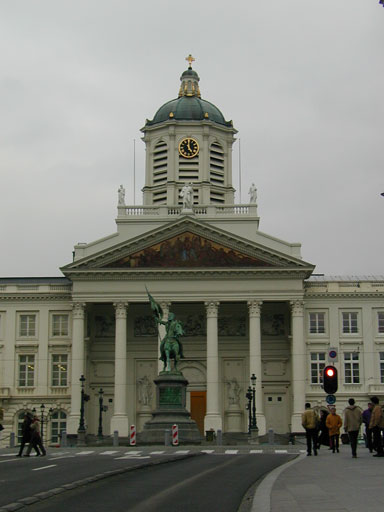- Date
- 1 February 2000
1 February 2000 – This afternoon, I visited The Royal Museum of Fine Arts of Belgium and began with Peter Paul Rubens (1577-1640), a genius of Baroque art. ‘Four Negro Heads’ lacks frivolous adornments in the small portrait. ‘The Carrying of the Cross’, ‘The Martyrdom of St. Lieven’ and ‘The Adoration of the Magi’ are massive paintings. The color of red in all three of these paintings is extraordinarily vivid.
Jacob Jordeans (1593-1678) struck a cord with me. I enjoyed ‘Allegory of Fertility’ with a nymph’s backside as the focal point. The painting celebrates Pomona, a Roman goddess known to be exceptional at gathering fruits and tending gardens. A naked man squats in the left-hand corner of the painting balancing on the balls of his feet. The detail and realism is remarkable.
Jacques Louis David’s (1748-1825) ‘Death of Marat’ shows that consequences in 1793 of mixing journalism and politics. Marat was a radical newspaper editor. Charlotte Corday believed Marat contributed to the massacres that led to the Revolution so she stabbed him to death on 13 July 1793. Then David was asked to do a memorial painting. Marat worked often in his tub, due to a skin ailment, so David’s painting shows Marat dead in a tub but with paper in hand, inkwell present and feather pen dropped as a result of death. The paper is Corday’s letter, “… my deepest Grief is all it Takes to be Entitled to your benevolence”.
Fernand Khnopff (1858-1921)’s ‘Memories’ (of Lawn Tennis) has seven women standing proud on the lawn, five of them with racquets but none in motion. They look like models instead of participants. Each of the five women has the face of Khnopff’s sister Marguerite. Another painting, ‘Portrait of Marguerite’, shows his sister wearing a long, fitted dress and gloves yet all the coverings just accentuate her feminine body.
My untrained eye saw a futuristic approach in the work of Paul Delvaux (1879-1953). He refused to participate in the Surrealist movement but the similarities to the style of painting are strong. In Pygmalion, Delvaux alters the sex of the characters from the legendary story with a nude woman wrapping her arms around a male statue. A woman on the right is in bloom with flowers and foliage sprouting from her head and chest. In ‘La Voix Publique’, a Venus reclines while three women behind her look on. The nude Venus has one leg covered by a cloth, the other is elongated and one arm rests behind her head. Standing behind the naked creature, apparently in judgment of her, are three women, dressed identically in black with purple bows around their necks. The museum suggests the reclining woman is reminiscent of a woman relaxing in a brothel window.
Rene Magritte (1898-1967) continues to fascinate me with his strange and surreal offerings. I especially like his later nude females because he casts them beautifully with wonderful pastels.
Marcel Broodthaers (1924-1976) constructed ‘Red Mussels Casserole’ – a cast iron pot painted red with mussels glued inside. Broodthaers was a poet and Surrealist in thought. He used eggshells, mussels and ordinary objects to create art.









